2 Plate Tectonics
“Plate motions have built the topography that has induced the weather that has brought the fire that has prepared the topography for city-wrecking flows of rock debris. Plate motions are benign, fatal, eternal, causal, beneficial, ruinous, continual, and inevitable.”
John McPhee, 1994, New Yorker
after the Northridge Earthquake
1. The Earth’s Crust: Not Very Well Designed
As an engineered structure, the Earth’s crust is not up to code. From time to time, its design problems cause it to fail, and the result is an earthquake.
The principal cause of crustal weakness is geothermal heat. Isotopes of radioactive elements within the Earth decay to other isotopes, producing heat that is trapped beneath the surface. Because of this trapped heat, the crust is warmer with increasing depth, as anyone knows who has ever descended into a deep mine. Geothermal heat warms the City of Klamath Falls, Oregon, heats the hot springs of the Pacific Northwest, and, on rare occasion, causes the eruption of great volcanoes like Mt. St. Helens.
Just as iron becomes malleable in a blast furnace, or hot silica glass becomes soft enough for a glassblower to produce beautiful bowls, rock becomes weak, like saltwater taffy, when the temperature gets high enough (Figure 2-1). Rock that is soft and weak under these conditions is said to be ductile. At lower temperatures, rock is brittle, meaning it deforms by shattering, accompanied by earthquakes.
Increased temperature tends to weaken rock, but, on the other hand, increased pressure tends to strengthen it. With increasing depth, rock is subjected to conditions that work in opposite directions. The strengthening effect of increased pressure dominates at low temperatures within ten to twenty miles of the Earth’s surface, whereas the weakening effect of higher temperature kicks in rather abruptly at greater depth, depending on the type of rock. The strength of rock, then, increases gradually with increasing depth, and the strongest rock is found just above the depth where temperature weakening takes over (Figure 2-1), a depth called the brittle-ductile transition.
Think about a bridge with a layer of asphalt and concrete overlying a framework of strong steel. If the bridge collapses, it will be because the steel frame fails, not the weaker layers of concrete or asphalt on top. So it is with the Earth’s crust. The crust fails when its strongest layer breaks, just above the brittle-ductile transition where temperature begins to weaken its minerals. Earthquakes tend to originate in this strongest layer. When this layer fails, shallower and deeper rock fails, too.
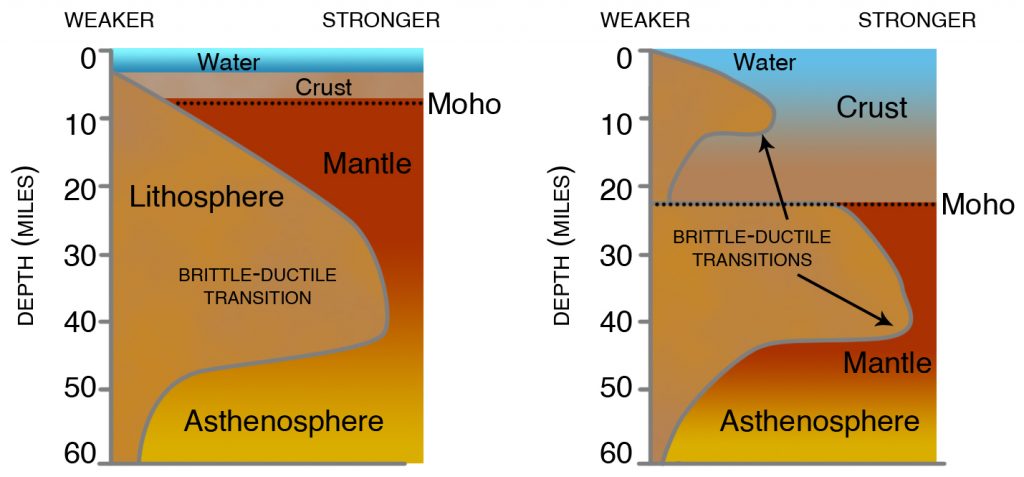
2. Continents and Ocean Basins
Unlike the other inner planets, the surface of the Earth is at two predominant levels, one averaging 2,750 feet (840 m) above sea level, making up the continents, where we all live, and the other averaging 12,100 feet (3,700 m) below sea level, making up the ocean basins (Figure 2-2). If you were able to look at the Earth with the water removed, the continents, together with their submerged continental shelves, would appear as gigantic plateaus, with steep slopes down to the ocean basins below (Figure 2-3a, b, 2-4). With the seawater removed, the dry land of the North American continent would appear as a high plateau relative to the deep-sea floor.
Figure 2-3a shows the Earth with the water removed. Continents are large plateaus above sea level, and ocean basins, in blue, show oceanic spreading centers in very light blue and trenches, marking subduction zones, in very dark blue. Figure 3b shows the Earth divided into tectonic plates, with subduction zones marked by heavy black lines and ocean spreading centers by narrower lines. Large earthquakes are shown as red dots. Note the Pacific Ring of Fire. Figure 2-4 shows the Gorda Plate with the water removed, with narrow lines marking the present and former position of the Gorda spreading center. Most earthquake energy is released along these plate boundaries, although the spreading centers are also marked by earthquakes (Figure 2-5).
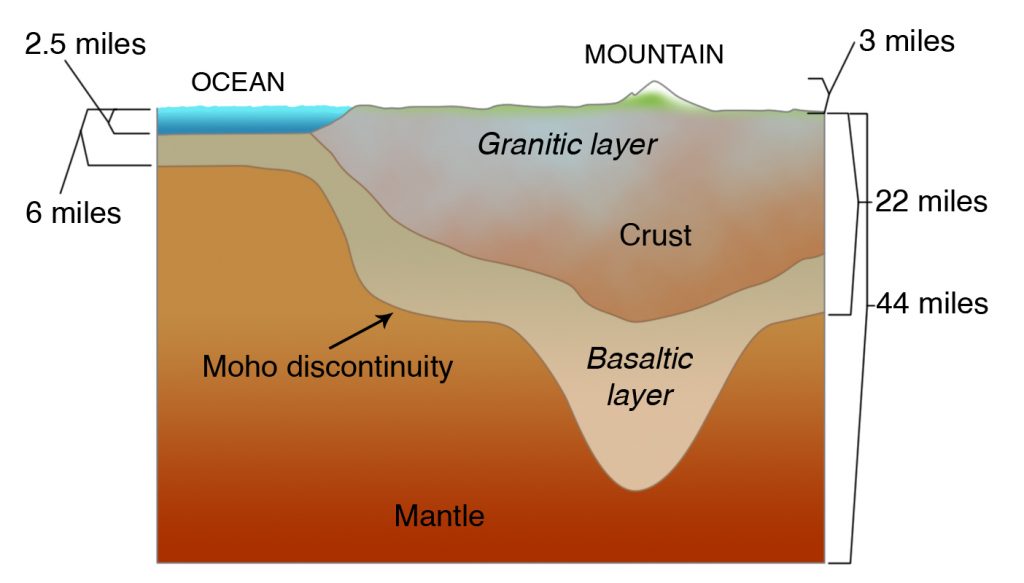
Imagine yourself flying northward along the northern California coast with all the seawater removed (Figure 2-4). You would look westward from the Oregon and northern California Coast Range to a narrow continental shelf, which, indeed, was dry land at the height of the ice ages when sea level was nearly four hundred feet lower than it is today. Beyond that, the land slopes downward for thousands of feet to the present deep ocean floor, part of the Gorda Plate (Figure 2-6). North of the Columbia River, the deep slope off the coast of Washington is cut by a series of twisting canyons rivaling the Grand Canyon in size. The Strait of Juan de Fuca is a broad valley separating the Olympic Peninsula from Vancouver Island, which is itself connected to the mainland by a series of islands. Puget Sound is another valley, similar to the Willamette Valley. But it is the steep slope between the continental shelf and the deep ocean floor that dominates the scene. It’s as though people living on the Pacific coast were in Tibet, looking down to the plains of India far below (figures 2-3a, 2-4).
The reason for the different levels is that the continents and ocean basins are made up of different kinds of rock. Continental rocks are rich in the light-colored minerals quartz and feldspar, which combine to make up the principal kind of rock in the continent, which is granite (Figure 2-2). You can find good exposures of light-colored granitic rocks in the Coast Mountains of British Columbia, the North Cascades of Washington, including the Alpine Lakes Wilderness Area east of Seattle, the Wallowa Mountains of Oregon, and the Sierra Nevada of California (which John Muir, because of their light color, called “The Mountains of Light”).
Ocean-basin rock, on the other hand, is predominantly basalt, which contains the light-colored mineral feldspar but is dark brown to black, because its color is dominated by dark minerals like pyroxene and magnetite. The mountains on the east side of the Olympic Peninsula, visible from Seattle on a clear day, are composed of basalt, with most of it deposited on an ancient ocean floor about fifty-five million years ago. Basalt lava flows also characterize the Columbia Plateau and Columbia Gorge, although these rocks were formed on the continent, not in an ocean basin. Basaltic rocks are common on other planets, whereas continental granitic rocks are not.
A third type of rock called peridotite underlies both the continents and the ocean basins, and this is made up of dense minerals such as pyroxene and olivine. This dark rock has no feldspar and thus it is heavier than either basalt or granite. Peridotite is also brittle and strong at much higher temperatures than either basalt or granite, a fact that will become significant when we consider in Chapter 5 the environment of deep earthquakes beneath the Puget Sound region.
Peridotite does not form naturally at the Earth’s surface. It is found at the surface only in special circumstances where great tectonic forces have raised it up to view. As it comes to the surface, it absorbs water, and the green streaky rock that results is called serpentine, which has been designated the state rock of California. Serpentine and peridotite are found at various places in the North Cascades of Washington, the Blue Mountains of Oregon, and the Klamath Mountains of Oregon and northern California. From a distance, terrain underlain by peridotite or serpentine may appear a weathered reddish brown, and it does not support as much vegetation as other types of rock. The Twin Sisters range east of Bellingham, Washington, is made up almost entirely of olivine, one of the minerals in peridotite, and the mountains south and west of Mt. Stuart, in the North Cascades north of Ellensburg, Washington, are made up of peridotite.
During the four and a half billion years of Earth history, convection currents sweeping at extremely slow speeds through the Earth’s interior have resulted in the gradual accumulation of granite and basalt near the surface, much like scum floating on the top of a large pot of slowly boiling soup. Granite and basalt float on top because they are lower in density than peridotite.
Basalt and granite make up the crust, and the underlying heavy peridotite makes up the mantle, which extends all the way down to the top of the molten outer core of the Earth at 1,800 miles (2,900 kilometers) depth. The boundary between the crust and the mantle is called the Moho (Figures 2-1 and 2-2), shorthand for the name of the Croatian seismologist, Andrija Mohorovičić, who discovered it in 1909. The Moho beneath the continents is commonly at depths of 20 to 40 miles (35 to 70 kilometers), deepest beneath mountain ranges, whereas the Moho beneath ocean basins may be no more than 6 miles beneath the sea floor.
The continents, made up of granite, which has relatively low density, stand higher than the ocean basins underlain by basalt and peridotite for the same reason that icebergs float on the ocean, or ice cubes float in a glass of ice tea. And if you look at the ice cubes in your tea, you will see that there is quite a lot of ice below the surface of the tea. This ice of lower density beneath the surface balances and buoys up the ice that sticks up above the water. For the same reason, the granitic crust of the continents extends to depths in the Earth much greater than the basaltic crust of the ocean basins (Figure 2-2). The basaltic crust beneath ocean basins is relatively thin, and its relation to the mantle is more like the water freezing on the surface of a pond.
But how can we use ice and water as a comparison with solid rock? Water is a liquid, and the crust and mantle are solids.
This comparison is valid for two reasons. First, rock at great depth is weak because it is subjected to blast-furnace temperatures beneath the brittle-ductile transition. Second, the tectonic processes that cause continents to rise above ocean basins are extremely slow. We know from experiments that if the temperature is high enough, rock can flow as a solid, although it does so very slowly, fractions of an inch per year. This process, well known in metalworking, is called hot creep.
We have seen that earthquakes occur in the brittle upper crust, but not in the hot, plastic lower crust which is too weak to store strain energy that could be released as earthquakes. The reason for this is the abundance in the crust of the light-colored minerals quartz and feldspar, minerals that become soft and weak at relatively low temperature, about 575˚ F. For this reason, the upper crust beneath the continents is strong, but the lower crust is soft and weak. Oceanic crust, on the other hand, is so thin (Figure 2-2) that all of it is strong, and so is the upper mantle. Peridotite, the rock of the mantle, is made up of olivine and pyroxene, minerals that are still very strong at temperatures that prevail below the Moho, as high as 1,400-1,500˚F. These temperatures are reached at depths that may be as much as sixty miles (one hundred kilometers).
The part of the outer Earth that is brittle and strong is called the lithosphere, and the weak part below is called the asthenosphere. Beneath the ocean basins, the lithosphere includes the thin crust and part of the upper mantle. Beneath the continents, the upper crust is brittle, but the lower crust is not. Below the Moho, the upper mantle may also be brittle and form the lowest layer of continental lithosphere. So the continental crust can be compared to peanut butter between two crackers; both crackers are crunchy (brittle), but the peanut butter is soft (ductile lower crust). For oceanic lithosphere, you don’t have any peanut butter, and the crunchy cracker is a lot thicker.
The flow of solid rock in the asthenosphere produces strain in the strong lithosphere. It is the response of the lithosphere to this strain that causes earthquakes. All earthquakes occur within the lithosphere, including slabs of oceanic lithosphere that have been forced downward hundreds of miles into the asthenosphere.
3. The Dance of the Plates:
We Know the Beat, but Not the Tune
The dominant cause of the tectonic activity that takes place at the Earth’s surface is the extremely slow flow of rock in the mantle that is solid, yet ductile. This leads us now to a discussion of plate tectonics.
We would have no earthquake problem if the lithosphere, 60 miles thick, completely encircled the Earth without any breaks, as it does on the other inner planets. Unfortunately, though, the 60-mile thickness of the lithosphere on the “third rock from the sun” is not enough to withstand the stresses coming from the slow, roiling currents of the asthenosphere below. The lithosphere is broken up into gigantic tectonic plates (Figure 2-3a, 2-3b, 2-4) that grind against one another, producing earthquakes and volcanic eruptions in the process. Most of these plates are of continental size. The Pacific Northwest is part of the North American Plate, which extends all the way across the United States and Canada to the middle of the Atlantic Ocean (Fig. 2-3b). Most of the Pacific Ocean is underlain by the Pacific Plate, the world’s largest, which reaches to Alaska, Japan, and New Zealand (figure 2-3b). Other plates are smaller, like the Juan de Fuca Plate off the Pacific Northwest coast, which is a little smaller than Washington and Oregon taken together (Fig. 2-4b).
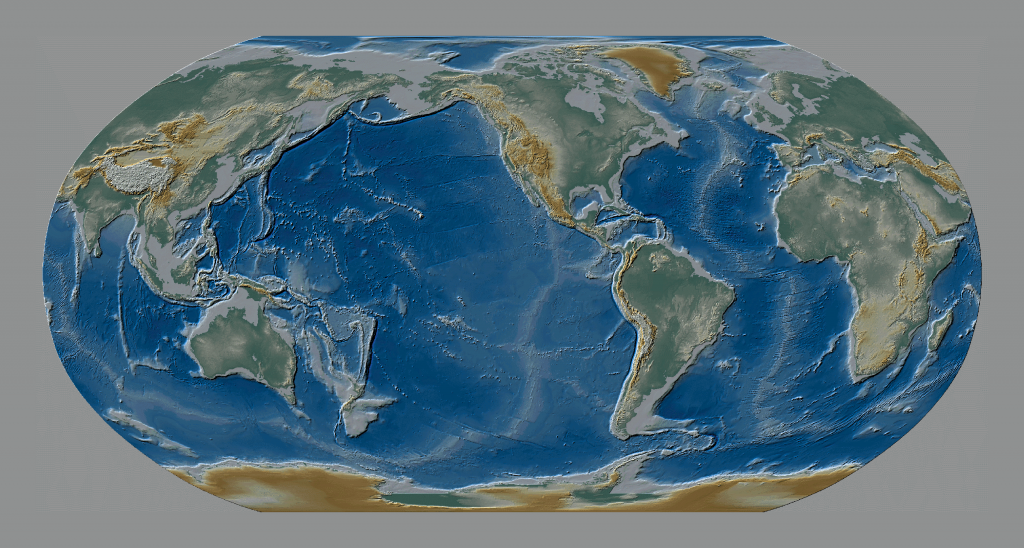
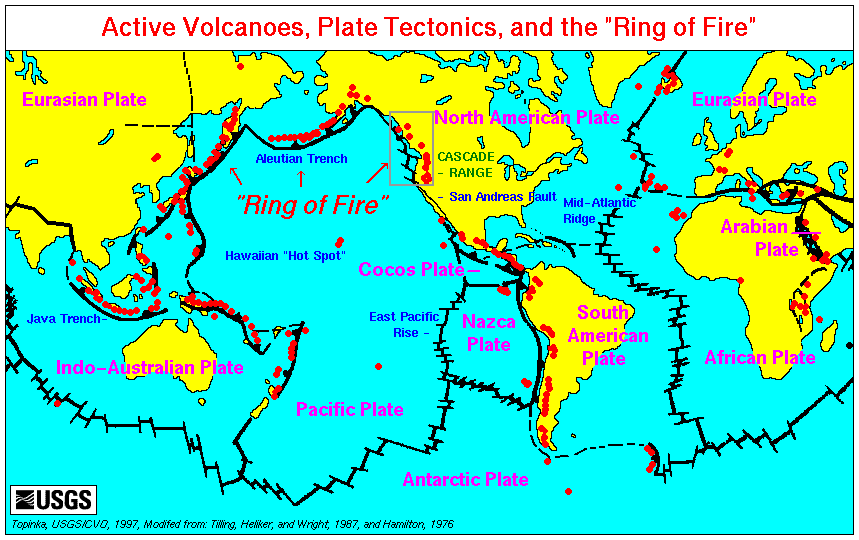
Running down the center of the floor of the Atlantic Ocean, like the seam on a baseball, the Mid-Atlantic Ridge (Figures 2-3a, b) is formed by the upwelling of hot material from the asthenosphere, which broke up the granite supercontinent of Pangea, starting about one hundred and eighty million years ago. North and South America, fragments of Pangea, sailed away from Africa and Eurasia like great granitic ice floes in a basaltic sea, and the deep Atlantic Ocean floor of basalt began to grow in the widening rift welling up between the continents. The Atlantic Ocean Basin is still widening at a rate slightly less than an inch per year. The Mid-Atlantic Ridge is a ridge (lighter blue, Figure 2-3a) because the newly formed oceanic lithosphere is hotter and thus lighter and more buoyant than older oceanic lithosphere closer to the continents. There are hot springs along the ridge, called black smokers (first discovered by marine scientists from OSU), and new basaltic lava flows erupt on the ocean floor at the ridge. All of the ocean floor of the Atlantic has been created as basaltic lava in the past one hundred and eighty million years.
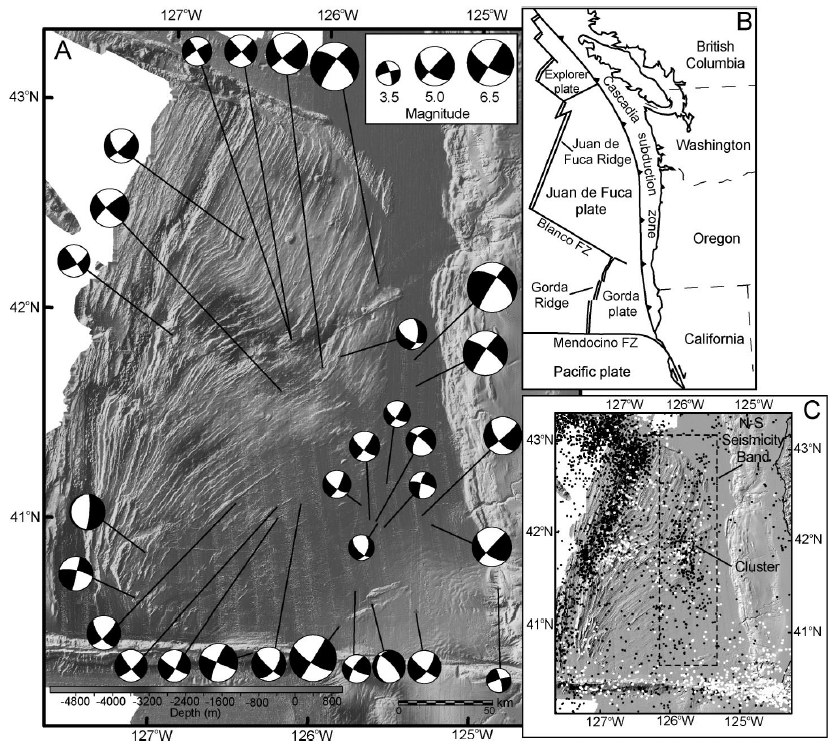
There is also a ridge in the Pacific Ocean called the East Pacific Rise, but this ridge is not at the center of the ocean, like the Mid-Atlantic Ridge. Instead, it lies toward the eastern margin of the Pacific (Figures 2-3a, b). But its origin is the same: oceanic crust rises to the surface and solidifies at the East Pacific Rise, then it moves away to the east and west. That part moving toward the west becomes part of the great Pacific Plate. That part moving toward the east becomes part of several smaller plates off the west coast of North and South America, including the Juan de Fuca Plate off the Pacific Northwest (Figure 2-4b, 2-6), and the Cocos Plate off Mexico and Central America (Figure 2-3b). These plates drive against and beneath the American continents.
But if new crust is being made, then old crust must be destroyed at the same rate somewhere else, because the Earth has remained the same size through time. The destruction of crust takes place at subduction zones, where oceanic lithosphere sinks down into the asthenosphere. Most subduction zones are found around the edges of the Pacific Ocean, which leads to the name Pacific Ring of Fire (Figure 2-3b) because of the abundance of active volcanoes and earthquakes, including the largest earthquakes experienced on Earth. The greatest depths in the oceans, nearly seven miles, are found in deep-sea trenches in the western Pacific (Figure 2-4, 2-5), where oceanic lithosphere is being subducted beneath the Philippines and beneath the Marianas Islands and the island of Guam. Volcanoes are erupted through the lithosphere of the plate on top.
One of these subduction zones, the Cascadia Subduction Zone, lies off the Pacific Northwest, including northern California, where the Juan de Fuca, Gorda, and Explorer plates are being driven beneath the North American continent (Figures 2-4, 2-5, 2-6). Mt. Baker, Mt. Rainier, Mt. St. Helens, Mt. Hood, Mt. Shasta, and Mt. Lassen are products of the subduction of the Juan de Fuca and Gorda plates. The Cascadia Subduction Zone is discussed further in Chapter 4.
At some plate boundaries, lithosphere is neither created at a mid-ocean ridge nor destroyed at a subduction zone. Instead, two plates crunch and grind past each other, producing earthquakes in the process. These boundaries are called transform faults, and on the ocean floor, they are called fracture zones. The best known transform fault on Earth is the San Andreas Fault of California (lower right corner of Figure 2-4b, Figure 2-6), where the Pacific and North American plates grate past each other. Off the Pacific Northwest, part of the boundary between the Juan de Fuca-Gorda and Pacific plates is the Blanco Fracture Zone, separating the Gorda and Juan de Fuca ridges (Figures 2-4c, 2-6, 2-7). Both the San Andreas Fault and the Blanco Fracture Zone are major sources of earthquakes.
Scientists are able to determine the rates at which the plates move with respect to one another. This is done by observing changes in the Earth’s magnetic field preserved in oceanic crust (Figure 2-6) and by drilling core holes in the deep-ocean floor to determine the age of the oldest sediment overlying the basaltic crust in various parts of the oceans. In the last few years, these rates have been confirmed by direct measurements using space satellites through the Global Positioning System (GPS) and by the relative motion of radio telescopes with respect to quasar signals from outermost space (discussed further in Chapter 3). All our information about relative plate motion can be fed into a computer model that tells us the motion of any given plate with respect to any other. We can even predict with some confidence the plate configuration of the Earth millions of years from now, which allows us to forecast that coastal California, including Los Angeles, is moving slowly but inexorably toward Alaska (video, Fig. 2-8).
However, we have no underlying theory that explains why the plates move as they do, which leads to our description of the dance of the plates: we know the beat, but we don’t know the tune.
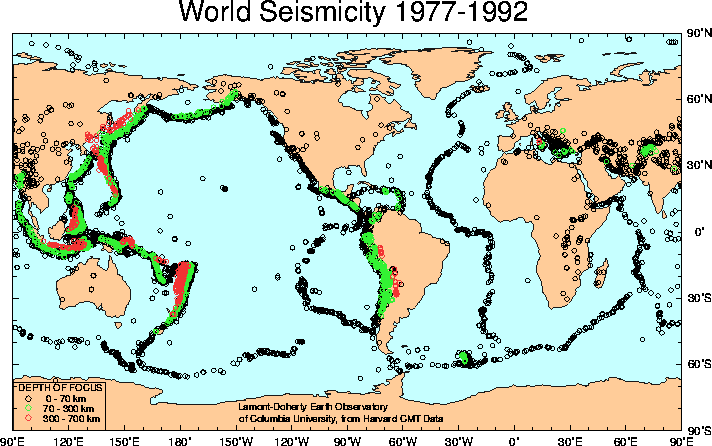
Near the tiny settlement of Petrolia in northern California, the Pacific, North America, and Gorda plates come together in a seismically active place called the Mendocino Triple Junction (Fig. 2-7). North of the triple junction, the Gorda Plate is driving beneath the North American continent (Figures 2-4 and 2-8). Southeast of the junction, North America is sliding southeast against the Pacific Plate along the San Andreas Transform Fault. West of the junction, the Pacific Plate is sliding westward against the Gorda Plate along an oceanic transform fault called the Mendocino Fracture Zone (Figures 2-4, 2-6, and 2-7). We know the rates at which these processes are taking place, and so we can reconstruct the plate tectonic history of western North America backward for the past thirty million years.
4. A Brief Thirty-Million-Year History of Western North America
Using sophisticated computer models, it is fairly straightforward to work out the plate-tectonic history of the Earth for hundreds of millions of years. This is illustrated in five stages in Figure 2-7, based on a copyrighted video created by Prof. Tanya Atwater of the University of California Santa Barbara through its Educational Multimedia Visualization Center and shown here as Figure 2-8. For an explanation in greater depth, see Atwater (1989).
What did the Pacific Northwest look like thirty million years ago?
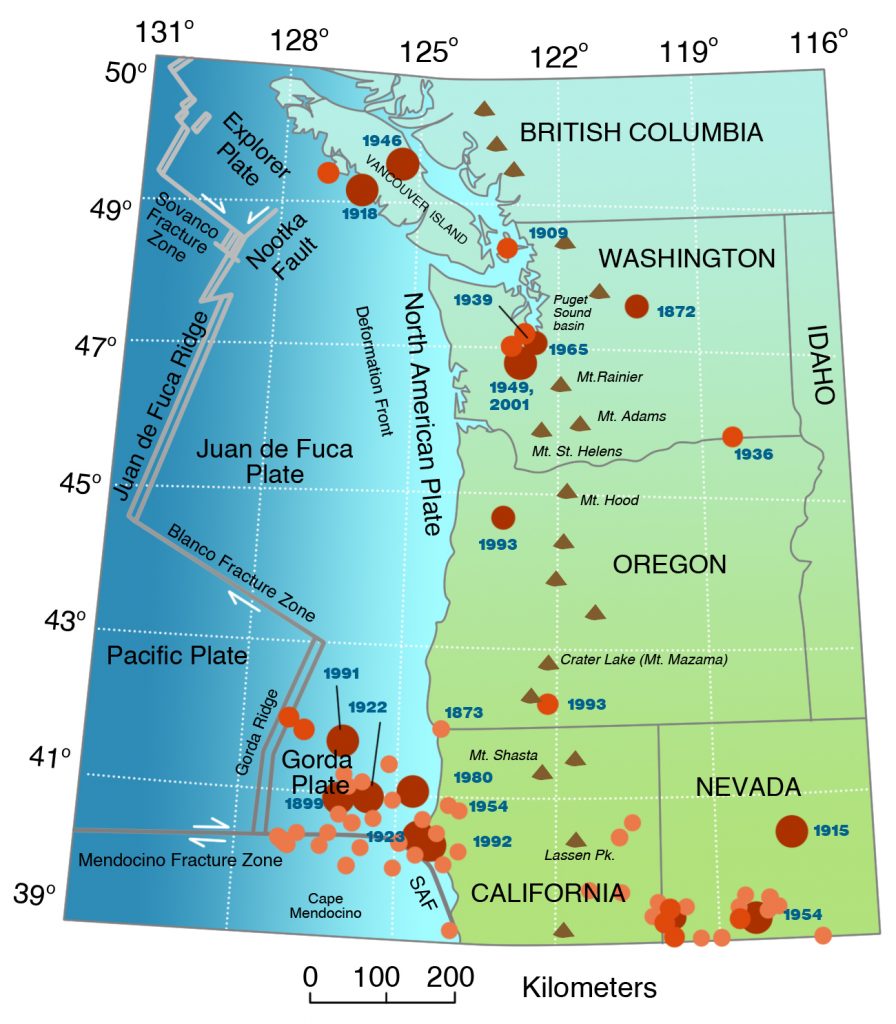
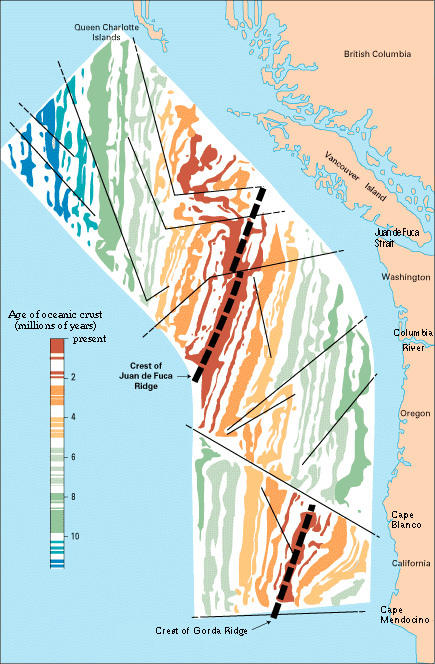
At that time, the oceanic crust west of North America formed part of the Farallon Plate, not the Pacific Plate (Figure 2-7, 2-8), and the Farallon Plate was being subducted beneath North America. The Farallon Plate and Pacific Plate were separated by the East Pacific Rise, part of the world-encircling mountain system that marks where new oceanic crust is formed (Figure 2-3) and spreads away, and by the Mendocino Transform Fault, which at that time was west of what would later become Los Angeles (Figures 2-7, 2-8). The Baja California peninsula was part of the Mexican mainland, with no Gulf of California in between.

Sea-floor spreading on the Mid-Atlantic Ridge had been forcing North America westward, away from Europe and toward the East Pacific Rise (Figure 2-3b). The Farallon Plate was being slowly subducted beneath North America, and active volcanoes erupted through the Cascades, the California Coast Range, and Baja California. The lofty cones of these old volcanoes were eroded away, and only the roots of the volcanoes are preserved in the deeply eroded mountains. As the Farallon Plate continued to be slowly consumed, the Pacific Plate came into contact with the North America Plate. But the Farallon Plate had been moving eastward, toward the continent, whereas the Pacific Plate was moving northwest, parallel to the continental edge. So, after the plates came into contact, the Pacific Plate moved northwest past North America along a new transform fault at the base of the continental slope, a forerunner to the San Andreas Fault (Figure 2-7, 20 My and 10 My). The Mendocino Triple Junction moved northwest, too, and the San Andreas ancestor grew in length as the former Farallon Plate broke up into the Juan de Fuca Plate off northern California, Oregon, Washington, and Vancouver Island, and the Cocos Plate off Mexico and Central America. Lavas continued to be spewed out in the Pacific Northwest and in Mexico even as they stopped along the transform fault in California.
About 4.5 million years ago, the transform fault shifted inland to its present position within the continent as the San Andreas Fault, and Baja California broke away from the rest of Mexico, leaving the Gulf of California in its wake. The Gulf of California is an ocean basin in the making, like the Atlantic Ocean one hundred and eighty million years ago, when the Americas were close to Europe and Africa. Baja California began to drift off to the northwest, taking coastal Alta California along with it and leaving new ocean floor in its wake. The deep parts of the Gulf are mini-ocean basins called spreading centers. Basalt lava and hot springs are found in them, just as they are in the Mid-Atlantic Ridge and East Pacific Rise. The northernmost spreading center, oddly enough, is in the Imperial Valley, where continental crust is being pulled apart at the same time that, and the gap is being filled by sediments of the Colorado River.
The Juan de Fuca Plate is breaking off the Gorda Plate along the Blanco Transform Fault (Figure 2-4b, 2-7), and the Rivera Plate (RP in the top map of Figure 2-7), part of the former Cocos Plate, has appeared at the mouth of the Gulf of California. Subduction still continues today in the Pacific Northwest and in Mexico south of the Gulf, accompanied by active volcanoes.
Visualization of these examples of plate tectonics stretches the imagination until we recall that this has taken thirty million years, a length of time that overwhelms our ability to understand it. We are forced to put our imagination of natural processes into ultra-high speed, so that lifetimes flash by in a couple of seconds, and there is a plate-boundary subduction-zone earthquake at Cascadia every fifteen seconds. Even at that rate, the disappearance of the Farallon Plate would seem extraordinarily slow. If you were watching it as you would a movie, bring lots of popcorn. In fact, you can watch it. Tanya Atwater of the University of California, Santa Barbara, has created a video of the last thirty million years, animating the plate tectonics shown in Figure 2-8. Enjoy!
Suggestions for Further Reading
Atwater, Tanya, 1989, Plate tectonic history of the northeast Pacific and western North America, in Winterer, E., Hussong, D., and Decker, R., eds., The Eastern Pacific Ocean and Hawaii: Geological Society of America Decade of North American Geology v. N, p. 21-72.
Glen, W., 1982. The Road to Jaramillo. Stanford, CA: Stanford University Press. An account of the plate tectonics revolution.
Kearey, P., and F. J. Vine. 1990. Global Tectonics. London: Blackwell Scientific Publications, 302 p.
Kious, W. J., and R. I. Tilling. 1996. This Dynamic Earth: the Story of Plate Tectonics: U.S. Geological Survey. Out of print, but on the web at http://pubs.usgs.gov/publications/text/dynamic.html.
Lillie, R. J. 1999. Whole-Earth Geophysics. Englewood Cliffs, N.J.: Prentice-Hall, 361 p.

